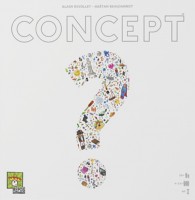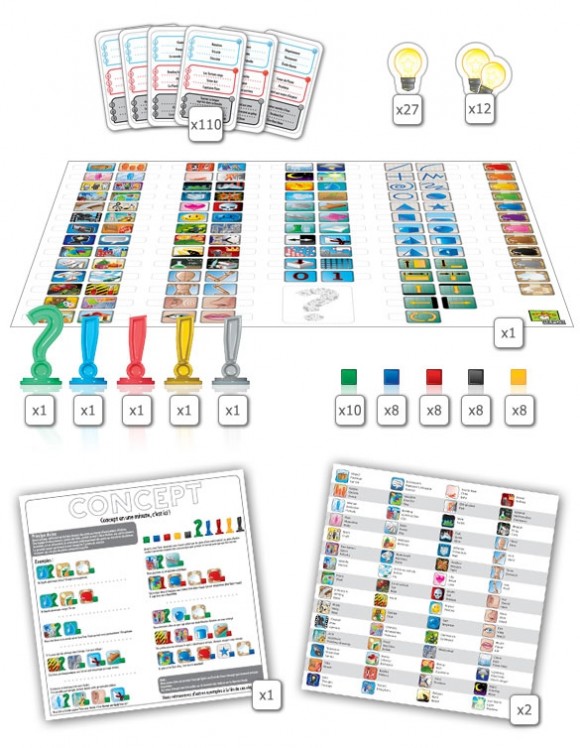
Concept
4-12
10+
40
A large, green animal from long ago? Must be a dinosaur. Water, cube and cold weather? Has to be an ice cube. A man with a job who rides large brown animals in the United States? Is that a cowboy?
In Concept, players team up to place tokens on a board covered in icons, depicting everything from ancient samurai and snails to Leonardo DiCaprio. Points go to the player who can guess the correctly by looking at the various symbols, but in this wild party game, the points are less important than just having a great time!

FEATURES
- Engaging and fun for the whole family.
- Use your creativity and imagination to solve the riddles from the visual clues.
- Easy rules have everyone playing in minutes.
User Reviews (2)
Add a Review for "Concept"
You must be logged in to add a review.


Initial Thoughts
Looking for a game that has the same…well…concept as charades without the awkwardness? The imaginative flexibility of Pictionary without the drawing? You’re in luck. Swapping out the gesticulations and scribbling for ambiguous, general pictures, Concept requires the same sort of lateral thinking to understand that Animal + Nose + Red + Cold = Rudolph the Red-Nosed Reindeer.
What’s In The Box?
110 cards
5 pawns (a green question mark, and blue, red, yellow, and black exclamation points)
10 green cubes
32 cubes (8 blue, 8 red, 8 yellow, and 8 black)
1 point & 2 point victory markers
Storage bowl for the cubes
2 game aids to help navigate all of the concepts
Gameplay
The game’s premise is deceptively simple: place markers on the various concepts to convey the answers found on the game cards. The answers are separated into Easy (e.g. Angel), Medium (e.g. Bilbo Baggins), and Hard (“Hungry Like the Wolf”). You’ll find that, as you continue playing, some of those easy and even medium items are trickier than the hard ones.
After you decide on an answer, you place the green question mark on the concept that you feel is the main one—keeping in mind how the other people at the table think. Would the main concept for Bilbo Baggins be a person, or literature, or movie? Do you mention that he’s a fantasy person and that he’s short? Using the concepts, can you get across that he has to walk a long way? Do you use the circle concept to imply a ring is involved? You can place up to four exclamation points under what you would consider sub-concepts. You also have color coordinated cubes that match all of the pawns to go as far down your conceptual rabbit hole as you and your teammates can handle.
While the game does come with one and two point scoring tokens, the real joy in the game comes from the interaction (or lack thereof) among the teams as they try to deduce the answer from the pawns and cubes scattered across the board. My family can get pretty competitive, but we found the game was more enjoyable without points and just laughs and applause for our efforts.
Final Thoughts
Concept is perfect for the whole family. It rewards creativity and imagination regardless of age or previous gamer experience. It’s terrific as an icebreaker for a group just getting to know each other, and it can be made cutthroat enough to satisfy a competitive family (like mine).
As a video gamer, I’ve always had trouble with open world games like Skyrim or the GTA series. When I’m given unlimited free rein and the ability to go anywhere and do anything, the sheer scope of the possibilities — and the fear of things I might be missing out on — contracts in on me to create a weird kind of claustrophobic feeling, paralyzed by the sheer number of choices. You may recognize this same sensation from your local ice cream parlor.
Yes, I’m going somewhere with this.
My family played Pictionary for a long time, and it eventually wore thin. Given the ultimate, terrifying freedom of a blank page, it’s easy to lock up, to feel unable to express the idea on the card because there’s no guidelines or structure to that empty white space. Concept is similar to Pictionary in that it’s a communication game, but where Pictionary gives you too much freedom to handle, Concept provides you with a very open structure in which to convey your message…and ends up better for it.
Much like Pictionary, in Concept, you’re given a word or phrase on a card to communicate to your partner(s). To attempt this communication, you’re given a large white game board with a huge variety of abstract symbols (all very colorful and pleasing to the eye) and markers of five different colors — the green question mark for the main concept, and then red, yellow, blue, and black exclamation marks for subconcepts. Every color also has small “supporting idea” cubes to flesh out the concept and subconcepts further. For example, for the clue “Tower of Babel,” my friend put the green question mark on the symbol for “building,” then green cubes on symbols for “book” and “religion.” He then put a yellow exclamation point on the arrow on top of a rectangle, indicating it was large (and stacked some yellow cubes for emphasis), then put a black exclamation point on the “quote” symbol and a black cube on the “spiral” symbol, which can stand in for madness or insanity.
In this way, you work to convey the concept to your team, and it makes for an amazing amount of fun. You’ll be desperately scanning the board for just the right symbol, stacking subconcepts and concept support cubes, agonizing over how to just make them understand! Similarly, trying to figure out the concept it great fun — everyone is shouting and laughing and alternating flashes of brilliant insight with hilariously wrong dead ends. You’ll know the struggle is real when you successfully convey “Mr. Potato Head” as “toy plastic / older man / plant round brown under ground / head” — which I successfully managed to pull off.
The rules are a little unstructured as well, but as far as I’m concerned, that’s okay. This is one of those party games where the experience is everything, and you’ll find yourself tossing aside the score tokens just to play a few more rounds. Every card has three sections (easy, hard, and challenging) with three concepts in each section, so you’re never at a loss. The board and pieces are clean and brightly colored with a well-designed minimalist kind of vibe. The concept icons are embedded into a large expanse of bright white, and the whole presentation feels very clean and sleek while maintaining a sense of heart and soul.
If I have a gripe about Concept, it’s mostly in the way that some people play it. It can be difficult to use the main concept/subconcepts/support cubes system, but using it skilfully is vital to effective communication. There are also a few concepts that I wish would have made it onto the board; e.g. “good” and “evil” would come in handy. But again, that’s part of the fun: taking all these abstract images and pulling them together to convey the greater concept. If you’re given too much, what’s the point?
As a fan of words and ideas and a sometimes-writer, I love Concept. All the friends I played it with — mathematical, rational, logical thinkers — loved it as well. It is very easy to learn, but extremely difficult to master. It’s also the most fun and (unusually for its genre) rewarding party game I’ve played in a very long time, and the sheer number of cards with nine concepts each make for immense replayability. Highly recommended for any and all game groups.